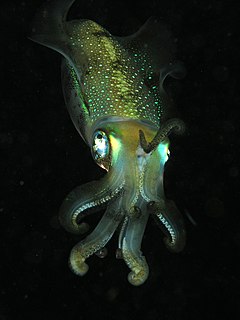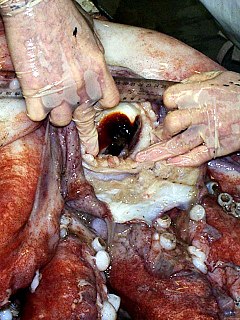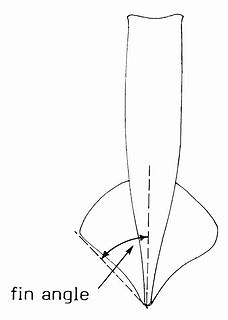
A cephalopod is any member of the molluscan class Cephalopoda such as a squid, octopus, cuttlefish, or nautilus. These exclusively marine animals are characterized by bilateral body symmetry, a prominent head, and a set of arms or tentacles modified from the primitive molluscan foot. Fishermen sometimes call cephalopods "inkfish," referring to their common ability to squirt ink. The study of cephalopods is a branch of malacology known as teuthology.

Spirula spirula is a species of deep-water squid-like cephalopod mollusk. It is the only extant member of the genus Spirula, the family Spirulidae, and the order Spirulida. Because of the shape of its internal shell, it is commonly known as the ram's horn squid or the little post horn squid. Because the live animal has a light-emitting organ, it is also sometimes known as the tail-light squid.

Nautiloids are a large and diverse group of marine cephalopods (Mollusca) belonging to the subclass Nautiloidea that began in the Late Cambrian and are represented today by the living Nautilus and Allonautilus. Nautiloids flourished during the early Paleozoic era, where they constituted the main predatory animals, and developed an extraordinary diversity of shell shapes and forms. Some 2,500 species of fossil nautiloids are known, but only a handful of species survive to the present day.
Cameroceras is a genus of extinct, giant orthoconic cephalopod that lived mainly during the Ordovician period. It first appears during the middle Ordovician, around 470 million years ago, and was a fairly common component of the fauna in some places during the period, inhabiting the shallow seas of Laurentia, Baltica and Siberia. Its diversity and abundance became severely reduced following the Ordovician–Silurian extinction events, and the last remnants of the genus went extinct sometime during the Wenlock.

Cephalopods vary enormously in size. The smallest are only about 1 centimetre (0.39 in) long and weigh less than 1 gram (0.035 oz) at maturity, while the largest—the giant and colossal squids—can exceed 10 metres (33 ft) in length and weigh close to half a tonne (1,100 lb), making them the largest living invertebrates. Living species range in mass more than three-billion-fold, or across nine orders of magnitude, from the lightest hatchlings to the heaviest adults. Certain cephalopod species are also noted for having individual body parts of exceptional size. The giant and colossal squids, for example, have the largest known eyes among living animals.
Clarkoceras is a genus of breviconic ellesmerocerid cephalopods, one of only two genera known to have crossed from the Late Cambrian, Trempealeauan, into the Early Ordovician, Gasconadian. ; the other being Ectenolites.
The Tarphycerida were the first of the coiled cephalopods, found in marine sediments from the Lower Ordovician to the Middle Devonian. Some, such as Aphetoceras and Estonioceras, are loosely coiled and gyroconic; others, such as Campbelloceras, Tarphyceras, and Trocholites, are tightly coiled, but evolute with all whorls showing. The body chamber of tarphycerids is typically long and tubular, as much as half the length of the containing whorl in most, greater than in the Silurian Ophidioceratidae. The Tarphycerida evolved from the elongated, compressed, exogastric Bassleroceratidae, probably Bassleroceras, around the end of the Gasconadian through forms like Aphetoceras. Close coiling developed rather quickly, and both gyroconic and evolute forms are found in the early middle Canadian.

Plectronoceras is the earliest known shelled cephalopod, dating to the Late Cambrian. None of the fossils are complete, and none show the apex or aperture of the shell. Approximately half of its shell was filled with septa; 7 were recorded in a 2 centimetres (0.79 in) shell. Its shell contains transverse septa separated by about half a millimetre, with a siphuncle on its concave side. Its morphology matches closely to that hypothesised for the last common ancestor of all cephalopods.

Volborthella is an animal of uncertain classification, whose fossils pre-date 530 million years ago. It has been considered for a period a cephalopod. However discoveries of more detailed fossils showed that Volborthella’s small, conical shell was not secreted but built from grains of the mineral silicon dioxide (silica), and that it was not divided into a series of compartments by septa as those of fossil shelled cephalopods and the living Nautilus are. This illusion was a result of the laminated texture of the organisms' tests. Therefore, Volborthella’s classification is now uncertain. It has been speculated that it may in fact represent a sclerite of a larger organism, on the basis of one specimen; however, it may be premature to accept this hypothesis, as the arrangement of sclerites producing this impression may have occurred by chance. The Ordovician scleritome-bearing Curviconophorus, as well as the Halwaxiids, lobopods and echinoderms, demonstrate the diversity of organisms which may produce a scleritome of this nature. The related Campitius was originally suggested to be part of a radula rather than a scleritome, but is now considered a synonym of Volborthella.
The Ellesmeroceratidae constitute a family within the cephalopod order Ellesmerocerida. They lived from the Upper Cambrian to the Lower Ordovician. They are characterized by straight and endogastric shells, often laterally compressed, so the dorso-ventral dimension is slightly greater than the lateral, with close spaced sutures having shallow lateral lobes and a generally large tubular ventro-marginal siphuncle with concave segments and irregularly spaced diaphragms. Connecting rings are thick and layered, externally straight but thickening inwardly with the maximum near the middle of the segment so as to leave concave depressions on internal siphuncle molds. Septal necks are typically orthochoanitic but vary in length from almost absent (achoanitic) to reaching halfway to the previous septum (hemichoanitic) and may even slope inwardly (loxochoanitic).
The cephalopods have a long geological history, with the first nautiloids found in late Cambrian strata, and purported stem-group representatives present in the earliest Cambrian lagerstätten.
Angaroceras is a conical Cambrian fossil originally classified as a cephalopod, but which is too poorly preserved for a classification to be upheld.
Olenecoceras is a genus of Middle Cambrian fossils that, once believed to be a cephalopod, has since been excluded from that group. The genus was established by Zakhar Grigor'evich Balashov in 1966, from the river Olenyok.

All extant cephalopods have a two-part beak, or rostrum, situated in the buccal mass and surrounded by the muscular head appendages. The dorsal (upper) mandible fits into the ventral (lower) mandible and together they function in a scissor-like fashion. The beak may also be referred to as the mandibles or jaws.

Cephalopod fins, sometimes known as wings, are paired flap-like locomotory appendages. They are found in ten-limbed cephalopods as well as in the eight-limbed cirrate octopuses and vampire squid. Many extinct cephalopod groups also possessed fins. Nautiluses and the more familiar incirrate octopuses lack swimming fins. An extreme development of the cephalopod fin is seen in the bigfin squid of the family Magnapinnidae.

Cephalopods exhibit various dermal structures on their mantles and other parts. These may take the form of conspicuous warts, cushions, papillae or scales, though in many species they are microscopic tubercles. The most elaborate forms are found among the oceanic squid of the order Teuthida.
Malcolm Roy Clarke FRS was a British marine biologist. He is most well known for his extensive work on cephalopods and whales.
Huaiheceras is a genus of ellesmerocerd from China, and type for the Heuhiceratidae that lived during the Late Cambrian. The shell is small, tubular, gently expanding and with a slight curvature. The siphuncle, which is proportionally narrow, is on the outer, concave curvature of the shell, suggesting it is exogastric. Septa are close spaced.

Louise Allcock is a British researcher, best known for her work on ecology and evolution of the cephalopods of the Southern Ocean and deep sea. She is the editor of the Zoological Journal of the Linnean Society.
Richard E. Young is a teuthologist. He is an Emeritus Professor of Oceanography at the University of Hawaii's School of Ocean and Earth Science and Technology.









